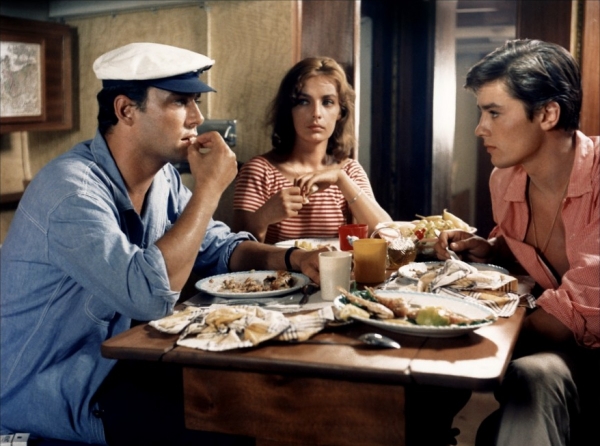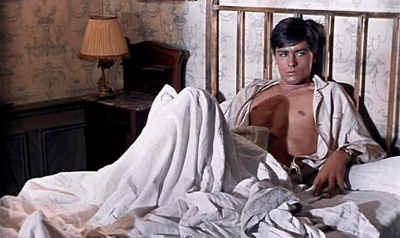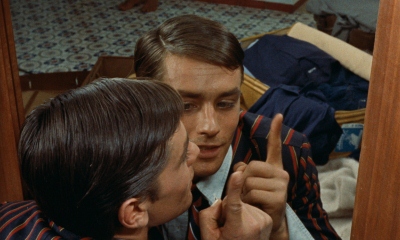“Purple Noon,” recently released by Criterion, is the prize for FNB’s January-February reader giveaway. Michael Wilmington reviews.
Purple Noon/1960/Robert and Raymond Hakim/118 min.
“Plein Soleil,” or “Purple Noon” is a classic thriller and an exceptionally riveting and beautiful movie about desire and cruelty, murder and malice. It’s a smoke-and-mirrors game of make-believe played by a psychopathic killer, a villain from a classic of 20th Century crime fiction – 1955’s “The Talented Mr. Ripley” by the brilliant American novelist Patricia Highsmith.

Alain Delon (right) plays Tom Ripley, a conman who fools a reckless playboy named Philippe (Maurice Ronet) and his girl, Marge (Marie Laforêt). The movie was adapted from Patricia Highsmith’s novel.
Shot in Italy, we first meet Ripley in the Bay of Naples, on a sailboat, surrounded by blazing sunlight (“plein soleil”). Two good-looking young men are laughing and smiling. The joke is that one of them, a handsome, penniless hanger-on named Tom Ripley (Alain Delon), will kill the other one, a rich, reckless playboy named Philippe Greenleaf (Maurice Ronet), assume his identity, take his money, and maybe seduce his girl, Marge (Marie Laforêt).
They are both laughing (but Philippe’s eyes are wary, Tom’s predatory), smiling with the special joie de vivre and cruel merriment of the young and careless – the high giddy spirits of, say, Robert Walker as Bruno Anthony planning his criss-cross murder with Farley Granger as Guy Haines in Highsmith and Alfred Hitchcock’s “Strangers on a Train.” But then Tom really kills Philippe. A knife thrust. A scream. “Marge!” cries the victim, the knife stuck in his chest. When the murder comes, it’s so swift, so effortless, so unexpected, yet so oddly inevitable, that it’s hard to believe we’ve seen what we’ve seen.
Released in 1960, the same year as “Psycho” and “La Dolce Vita,” “Purple Noon” was an off-type movie for French filmmaker René Clément, a gifted and highly regarded director, who, by 1960, had won two major Cannes Film Festival awards, two Oscars (for 1949’s “The Walls of Malapaga” and 1952’s “Forbidden Games”) and two Golden Lions at Venice. In 1946, Clement had served as Jean Cocteau’s “technical adviser” (his co-director, some think) on the romantic fantasy masterpiece “Beauty and the Beast.”
Clement was a technical genius who chose challenging subjects. But he had been famously attacked in an influential article by the young François Truffaut. Writing in Cahiers du Cinema, Truffaut accused Clement and other filmmakers of being pretentious, over-praised mediocrities. Truffaut was a great filmmaker and a great film critic, but he sometimes said nasty and unfair things (as he admitted in later years) to draw attention to himself and kick up controversy. His dismissal of Clement was one of his bigger critical injustices.
Did Clement take it to heart? Most tellingly, “Purple Noon” is obviously influenced by Hitchcock, whom all the young Cahiers du Cinema critic/directors loved (they called themselves the “Hitchcocko-Hawksians”). “Purple Noon” is a film that most of them would probably have liked to have directed, but didn’t. Couldn’t?
There is, however, a notable deviation from the Hitchcock thematic pattern. “Purple Noon” is not a movie about a wrong man falsely accused of a crime he hasn’t committed, like Cary Grant in “North by Northwest,” or Robert Donat in “The 39 Steps.”
In “Purple Noon,” Ripley is guilty. He’s a man trying to live a life that isn’t his, a life that belonged to the man he killed. “Purple Noon” is about the idle rich, and Ripley is a conman who wants to be idle and rich. Both Highsmith and Clement are unusually successful in getting us immersed in a story where most of the people are rich and selfish, where the leading man is irredeemably evil and the only really likeable character is Philippe’s abused girlfriend Marge, a writer with bad taste in men.
Ripley is in Italy at the behest of Philippe’s parents to talk Philippe into coming home. Instead, the guys become carousing hell-raising buddies. After the murder, Ripley takes Philippe’s bank records, fakes a passport, forges Philippe’s signature, imitates his voice on the phone, and lays a paper trail of hotel receipts to pretend that the dead man is still alive, still joy-riding somewhere around Italy.
Ripley is the real killer, constantly being mistaken for his own victim. It’s a brilliant Highsmith idea, and one that generates near-constant suspense, especially in the great scene when Ripley, disguised as Philippe, is confronted by Philippe’s suspicious friend Freddy Miles (Bill Kearns). That Tom-and-Freddy chase was also the only great scene in Anthony Minghella’s 1999 American movie version of “The Talented Mr. Ripley,” with Matt Damon miscast as Ripley. And the only reason that scene was great was because of Philip Seymour Hoffman’s marvelously snide performance as Freddy.
There’s a great performance in “Purple Noon” too: the tigerishly seductive Alain Delon, in his first important part. Delon is one of those impossibly good-looking actors who get careers they seemingly don’t really deserve (and that Delon said he initially didn’t want), but whose looks the movies feed on, and whom, it is said, the camera loves.
Delon, a working-class Adonis, is one of the few actors who could play, as he does here, a believable love scene with his own reflection in the mirror. We may not want Ripley to escape, but he generates unusual simpatico for a cold-blooded swindler and killer. And Maurice Ronet, with his haunted eyes and bedazzled smile, is just right as the irresponsible Philippe.
Delon, of course, was wrong for the part of Ripley in one major respect. It is impossible to believe that he (or Ronet) is an American. But in other respects, he’s an apt choice, and once you see him in the part, it’s hard to discard his image. (Damon, by contrast, though he’s played some movie villains, seems inherently too nice a guy for Ripley.)
Clement made the kind of thriller Truffaut would have loved to have made, but never did. And for the rest of Clement’s career, he was often typed as a thriller specialist, because of “Purple Noon,” which became one of the most influential of all French crime/suspense movies.
It deserves to be. “Purple Noon” still plays beautifully, especially in the scenes where Ripley battles the elements after the murder. Two years later, in 1962, a talented young Polish film director, Roman Polanski, made a thriller, set on a sailboat, that reminds you greatly of the bay scenes in “Purple Noon.” (“Knife in the Water” became an international hit and eventually brought Polanski to Hollywood where he made superb mass-audience thrillers like “Rosemary’s Baby” and “Chinatown.”)
I wish Clement had had a few more opportunities like Polanski did. Maybe Truffaut wished it as well. Maybe the maker of “The Four Hundred Blows” wished he hadn’t been so quick to thrust in the knife.
Extras: Interviews with Patricia Highsmith, Alain Delon and Clement scholar Denitza Bantcheva; Trailer; Booklet with a fine essay by Geoffrey O’Brien and a 1981 interview with René Clément.












From FNB readers